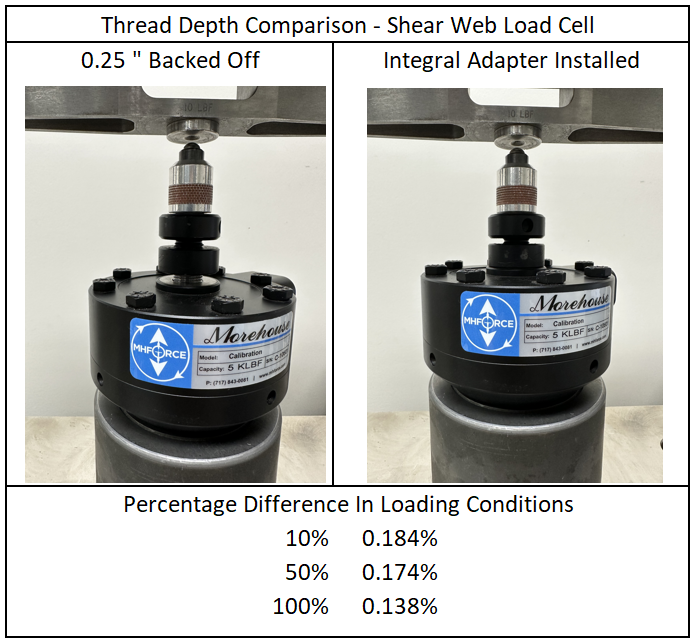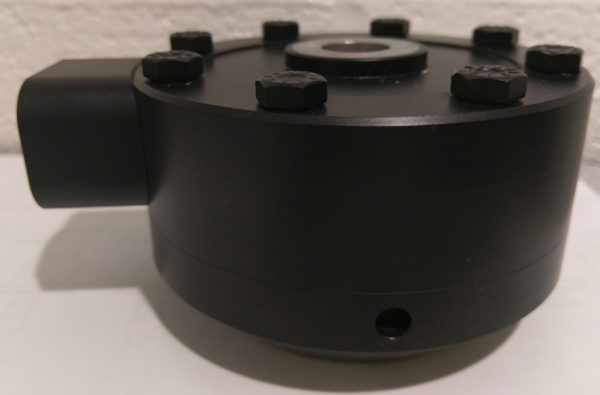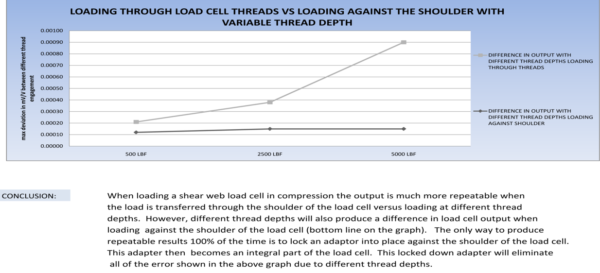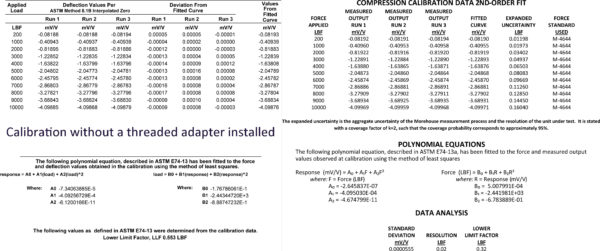How to Make Load Cells Perform Better - 3 Benefits of Installing a Threaded Adapter on Load Cells

How to make load cells perform better.
#1. The output of the load cell is more repeatable - When forces are applied to the load cell, the values obtained during calibration should repeat within the expected performance of the load cell.
Additional error sources from the different hardness of the material, misalignment, and temperature still apply.
#2. The technician can concentrate on alignment and other things instead of worrying about what adapters will yield a reproducible measurement.
Those who do not lock an adapter into place must ensure the thread engagement and fit are the same as the lab that calibrated the device.
Note: Do not remove the threaded adapter; it will void calibration.
These adapters are locked in at approximately 140 % of the rated capacity.
Removal of the adapter can damage the load cell if enough torque is applied, and getting the adapter to the same position it was in before removal is highly improbable.

The picture above shows an extreme difference between loading through the threads backed off about 0.25" or about 0.8 " of engagement. of threads and an integral adapter locked into place. Typically, someone will remove the adapter and try to lock it into place.
When this happens, the errors likely will be much less than above, though, without calibration, it is impossible to determine the difference.
If the load cell is used without the adapter, though calibration was with the adapter, these errors are relatively common.
#3. The load cell will repeat better when rotated per ASTM E74 – When a load cell is calibrated following ASTM E74, the load cell is positioned at orientations of 0 degrees, 120 degrees, and 240 degrees. Installing a threaded adapter improves the reproducibility of the load cell.
When we tested this on the same load cell, we observed an ASTM LLF of 0.32 LBF with a threaded adapter installed versus 0.553 LBF without the adapter installed.
The load cell with the threaded adaptor installed had a 42 % improvement in reproducibility.
How to Make Load Cells Perform Better - 3 Disadvantages of Not Installing a Threaded Adapter on Shear Web Load Cells


#1. The load cell output can vary depending on the engagement of the adapter - We performed several tests to prove this concept.
We demonstrate this in our two-day force fundamentals class, and we produce very significant errors each time.
We ran two full ASTM E74 calibrations, one without a threaded adapter, and then we locked a threaded adapter into place and ran another calibration.
The maximum difference in output was 0.044 %, as shown in the above table.

#2. Shoulder Loading is essential to minimize the thread depth error – When loading against the shoulder, we found an error of about 0.01 % by varying different adapters on a standard 10,000 lbf shear web cell.
Different load cells react differently, and shoulder loading does not guarantee repeatability within 0.01 %.
On a 3,000 lbf aluminum load cell, we found various adapters could change the output by as much as 1.16 %.
The best recommendation to limit this error source is to send your adapters to the lab performing the calibration and have them shoulder load the load cell.

#3. The reproducibility is not as good without a threaded adapter installed.
The above calibration data shows the reproducibility data and the effect on the ASTM LLF. Without the threaded adapter installed, the ASTM LLF was 0.553; with the threaded adapter installed, the ASTM LLF was 0.32 LBF.
Additional notes: Some say the word Adapter is used in American English, and Adaptor is used in British English. Since we ship worldwide, we used both :).
How to Make Load Cells Perform Better - Conclusion
How to make load cells perform better, invest in adapters?
If you enjoyed this article, check out our LinkedIn and YouTube channel for more helpful posts and videos.
We believe in changing how people think about how to make load cells perform better. Morehouse believes in thinking differently about force and torque calibration and equipment. We challenge the "just calibrate it" mentality by educating our customers on what matters and what causes significant errors and focus on reducing them.
Morehouse makes our products simple to use and user-friendly. And we happen to make great force equipment and provide unparalleled calibration services.
Do you want to do business with a company that focuses on what matters most? Please email us at info@mhforce.com.
#How to make load cells perform better


